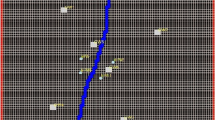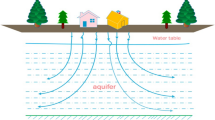Abstract
Groundwater management requires complete visualization of aquifer characteristics to understand scientific aspects and hence remains a challenge, especially in hard rock terrains. In the present research paper, a comprehensive approach using 3D stratigraphic model, fence diagrams and numerical modeling has been proposed to understand the groundwater status for effective recharge. The stratigraphy, groundwater flow, and groundwater fluctuations for the period 1999–2010 were analyzed. The total volume of formations, volume of voids, storage capacity, and quantities of recharge of unconfined aquifer system in the Nagpur urban area were estimated. The steady state groundwater flow model of Basalt formation was calibrated to evaluate the subsurface system using Processing Modflow (PMWIN 5.3.2). The calibrated hydraulic head is compared with field observed head. The comparative spatial analysis presents a simple integrated approach in identifying zones with falling groundwater trends suitable for groundwater recharge in hard rock terrain in Nagpur urban area.














Similar content being viewed by others
References
Agarwal RG, Garg PK, Garg RD (2013) Remote sensing and gis based approach for identification of artificial recharge sites. Water Resour Manag 27:2671–2689
Beigi E, Tsai FTC (2014) GIS-based water budget framework for high-resolution groundwater recharge estimation of large-scale humid regions. J Hydrol Eng 1084–0699:05014004-(11)
CGWB (2007) Manual on artificial recharge of groundwater. Ministry of water resources, Central Ground Water Board, India
CGWB (2009) Annual Report 2009–2010 Faridabad. Central Ground Water Board Ministry of Water Resources Govt. of India
Gaaloul N (2014) GIS-based numerical modeling of aquifer recharge and saltwater intrusion in arid southeastern Tunisia. J Hydrol Eng 19(4):777–789
Ghazaw YM, Ghumman AR, Al-Salamah I, Khan QUZ (2014) Investigations of impact of recharge wells on groundwater in Buraydah by numerical modeling. Arab J Geoscie 39:713–724
Katpatal YB, Chavan CS (2012) Study of groundwater level profile in an unconfined aquifer: case study of Nagpur urban area, central India. Int J Civil Eng (IJCE) 1(2):25–34
Katpatal YB, Pophare AM, Bhushan RL (2014) A groundwater flow model for overexploited basaltic aquifer and Bazada formation in India. J Environ Earth Scie 72(11):4413–4425
Madhnure P (2014) Groundwater exploration and drilling problems encountered in basaltic and granitic terrain of Nanded District, Maharashtra. J Geological Soc India 84:341–351
Ojha R, Ramadas M, Rao SG (2013) Current and future challenges in groundwater i: modeling and management of resources. J Hydrologic Eng 1084 0699:A4014007 (21)
Salamasi F, Azamathulla H (2013) Determination of optimum relaxation coefficient using finite difference method for ground water flow. Arab J Geosci 6(9):3409–3415
Singh A (2013) Simulation and optimization modeling for the management of groundwater resources II: combined applications. J Irrig Drain Eng 0733-9437:04013021(10)
Surinaidu L, Rao VVSG, Srinivasa RN, Srinu S (2014) Hydrogeological and Groundwater modeling studies to estimate the groundwater inflows into the coal mines at different mine development stages using MODFLOW, Andhra Pradesh, India. J Water Res Industry 7-8:49–65
Turner RJ, Mansour MM, Dearden R, Dochartaigh BÉÓ, Hughes AG (2015) Improved understanding of groundwater flow in complex superficial deposits using three-dimensional geological-framework and groundwater models: an example from Glasgow, Scotland (UK). Hydrogeol J 23:493–506
Varade AM, Khare YD, Mondal NC, Muley S, Wankawar P, Raut P (2012) Identification of water conservation sites in a watershed (WRJ-2) of Nagpur District, Maharashtra using geographical information system (GIS) technique. J Indian Soc Remote Sensing 41(3):619–630
Varade AM, Shende R, Lamsoge B, Dongre K, Rajput A (2014) Efficacy of Kumarswamy method in determining aquifer parameters of large-diameter dugwells in Deccan Trap Region Nagpur District, Maharashtra. J Indian Geophysics 18(4):461–468
Varalakshmi V, Rao BV, SuriNaidu L, Tejaswini M (2014) Groundwater flow modeling of a hard rock aquifer: case study. J Hydrol Eng 19:877–886
Wang S, Shao J, Song X, Zhang Y, Huo Z, Zhou X (2008) Application of MODFLOW and geographic information system to groundwater flow simulation in North China Plain, China. Environ Geol 55(7):1449–1462
Zekri S, Ahmed M, Chaieb R, Ghaffour N (2014) Managed aquifer recharge using quaternary-treated wastewater: an economic perspective. Int J Water Res Development 30(2):246–261
Author information
Authors and Affiliations
Corresponding author
Rights and permissions
About this article
Cite this article
Ansari, T.A., Katpatal, Y.B. & Vasudeo, A.D. Integrated approach of geospatial visualization and modeling for groundwater management in hard rock terrains in Nagpur Urban Area, India. Arab J Geosci 9, 325 (2016). https://doi.org/10.1007/s12517-016-2357-2
Received:
Accepted:
Published:
DOI: https://doi.org/10.1007/s12517-016-2357-2




